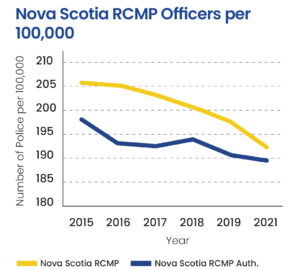Optimization of Police Resources in Nova Scotia
84% of Nova Scotians indicates that there is a need to increase resources for policing in rural and remote areas. (Pollara, July 2022)
The RCMP is well positioned to provide comprehensive policing services that are responsive to the unique community needs of Nova Scotians. However, RCMP services must be adequately resourced to enable Members to conduct their duties.
 In the past years, all police services across Canada have been facing resourcing shortages, spanning from challenges in recruitment to maintaining effective staffing levels. Since 2011, the rate of police strength in Canada [1] has either declined [i] of held stable rather than increased. [ii] This decline indicates the increased pressure on personnel resources, resulting in fewer police officers serving an ever-growing public population. These declines do not reflect day-to-day strength fluctuations, impacted by hard and soft vacancies or other resource strains that reduce the amount of available personnel.
In the past years, all police services across Canada have been facing resourcing shortages, spanning from challenges in recruitment to maintaining effective staffing levels. Since 2011, the rate of police strength in Canada [1] has either declined [i] of held stable rather than increased. [ii] This decline indicates the increased pressure on personnel resources, resulting in fewer police officers serving an ever-growing public population. These declines do not reflect day-to-day strength fluctuations, impacted by hard and soft vacancies or other resource strains that reduce the amount of available personnel.
During the mass casualty event, only four general duty Members were scheduled to work in the Bible Hill detachment as compared to the full staff complement of six Members. [iii]
Detachments regularly operate at the minimum complement, [iv] with none of the detachment or district supervision roles staffed on the weekend or after hours. [v] This is largely reflective of the lack of adequate resourcing for rural and remote policing across Nova Scotia.
The lack of resources during the mass casualty can also be seen in the specialized policing services in Nova Scotia. The Emergency Response Team (ERT) was also not operating at its recommended complement of 18 full-time Members. [vi] Off-duty Members were called on to stand-up a team of 12 to be deployed to the mass casualty event of April 2020, resulting in Members not completing necessary shift breaks and not ending their shifts as usual. [vii] This led to those Members working double or triple shifts. In addition to personnel shortages in the ERT, the Emergency Medical Response Team (EMRT) was also under-staffed. Only four out of six EMRT positions were filled in “H” Division and none were on-call at the beginning of the mass casualty event. [viii] Of these four filled positions there was no one available to serve in a coordination role for the team, greatly limiting its effectiveness.
FUNDING AND COST RECOVERY
- Under the Provincial Policing Service Agreement (PPSA) the federal government pays for 30% of the cost of policing with the province covering 70%.
- However, the current billing model used by the province follows a “per officer” cost. This means that municipalities can only reduce their police budgets by reducing the number of police officers in their area.
- Without minimum standards for police service levels across the province, this results in the decline in the number of officers exasperating resource shortages.
Recommendation 1: The Province of Nova Scotia discontinue the use of the “per officer” funding formula as a basis for cost recovery from municipalities policed by the RCMP under the PPSA, and conduct a review of its police resourcing models and funding formula, to allow for the identification and maintenance of an effective level of police personnel and resources in Nova Scotia.
Recommendation 2: The Province, RCMP, and municipal police services enter into formal cost-recovery agreements with respect to the provision of specialized services outside of RCMP contract jurisdiction.
Recommendation 3: The Province of Nova Scotia identify and support municipalities to maintain a minimum police strength in Nova Scotia that:
- Is effective for Nova Scotia’s current population;
- Maintains 24-hour service coverage across the province;
- Permits Members to respond rapidly to calls for service, with consideration for the vast geographic areas of rural Nova Scotia, road conditions, weather systems, and other obstacles;
- Is informed not only by trends in crime reporting, but also by other community needs and expectations;
- Enables Members to respond with a partner in dangerous situations, in calls for service where the presence of firearms is likely, and for other tasks requiring both communication and security roles (e.g., containment);
- Allows for proactive policing assignments that enable personnel to engage in consistent community policing activities and establish and maintain situated local knowledge; and
- Factors in “worst case scenario” and critical incident planning and preparedness.
Recommendation 4: The Province of Nova Scotia must immediately provide permanent stable funding for, and staff in “H” Division:
- 24 full-time ERT Members;
- One full-time EMRT Member in a coordinator and operational role; and
- Four full-time Police Dog Services positions.
[1] Calculated through the rate of officers per 100,000 individuals, population-wise
[i] December 2020. Police resources in Canada, 2019. [Online] Available at: https://www150.statcan.gc.ca/n1/pub/85-002-x/2020001/article/00015-eng.htm
[ii] April 2022. Police personnel and expenditures in Canada, 2021. [Online] Available at: https://www150.statcan.gc.ca/n1/pub/11-627-m/11-627-m2022013-eng.htm
[iii] Testimony of IARD Witness Panel, March 28, 2022, COMM0053615, p.11, lines 25-28
[iv] Testimony of Sgt. Andy O’Brien, May 31, 2022, COMM0058858, p. 9, line 21 to p. 10, line 12 https://masscasualtycommission.ca/files/fd-source-materials/additional-exhibits/COMM0058858.pdf?t=1668548171
[v] Testimony of S/Sgt. Bruce Briers, May 25, 2022, COMM0058605, p. 13, lines 1-2
[vi] Testimony of S/Sgt. Jeff West, May 18, 2022, COMM0058603, p. 81, lines 16-24; Testimony of Cpl. Tim Mills, May 16, 2022, COMM0058513, p. 68, lines 18-19 https://masscasualtycommission.ca/files/fd-source-materials/additional-exhibits/COMM0058603.pdf?t=1668548171
[vii] Testimony of Cpl. Mills and Cpl. Trenton, pg 27, Mass Casualty Commision COMM00585120028 https://masscasualtycommission.ca/files/documents/transcripts/EN_20220516_PublicHearings_Transcript.pdf
[viii] RCMP Emergency Medical Response Team After Action Report. Mass Caualty Commission COMM0054284 pg, 10 https://masscasualtycommission.ca/files/fd-source-materials/COMM0054284.pdf?t=1657567351
